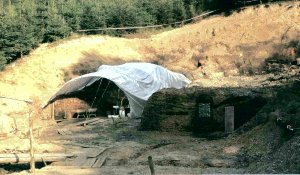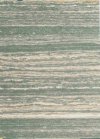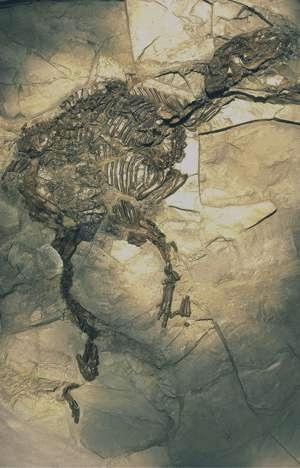 The main research project of the Naturhistorisches Museum Mainz and
the Landessammlung für Naturkunde Rheinland-Pfalz are the excavations in the so called
"Eckfelder Maar" near Manderscheid/Eifel. They are organized since 1987
by the Landessammlung Rheinland-Pfalz / Naturhistorisches Museum der Stadt
Mainz with the help of employees of the museum, volunteers, trainees and
workers on job-creating measures from Manderscheid. Scientific research
mainly of the flora and certain animal groups are done by the staff of
the museum. This significant research project is financed by the Deutsche
Forschungsgemeinschaft (DFG) and the Stiftung für Innovation Rheinland-Pfalz
and is pushed by a close cooperation with numerous German and foreign scientists
and institutions. Nevertheless, the scientific importance is demonstrated
by the impressive amount of about more than 100 scientific publications.
The main research project of the Naturhistorisches Museum Mainz and
the Landessammlung für Naturkunde Rheinland-Pfalz are the excavations in the so called
"Eckfelder Maar" near Manderscheid/Eifel. They are organized since 1987
by the Landessammlung Rheinland-Pfalz / Naturhistorisches Museum der Stadt
Mainz with the help of employees of the museum, volunteers, trainees and
workers on job-creating measures from Manderscheid. Scientific research
mainly of the flora and certain animal groups are done by the staff of
the museum. This significant research project is financed by the Deutsche
Forschungsgemeinschaft (DFG) and the Stiftung für Innovation Rheinland-Pfalz
and is pushed by a close cooperation with numerous German and foreign scientists
and institutions. Nevertheless, the scientific importance is demonstrated
by the impressive amount of about more than 100 scientific publications.
 The
isolated occurrence of fossil-bearing sediments near Eckfeld is known since
the last century. Its orign was disputed for a long time. The results of
geological-geophysical examinations and drillings show that the sediments
were deposited in a maar which has a recent diameter of 400 x 500 m. Its
initial diameter amounted to roughly 900m. The sediments consist of bitumious
laminites (fine-layered "oil-shales") and turbidites (coarser layers),
interlocking with marginal volcanic deposits of trachytic composition (pumice).
The investigations on the mammals makes it possible to date the fossil-bearing
sediments and to refer them to the stage MP13 (upper Middle Eocene, 44-45
Mio. a.). Therefore, Eckfeld is the oldest know maar so far.
The
isolated occurrence of fossil-bearing sediments near Eckfeld is known since
the last century. Its orign was disputed for a long time. The results of
geological-geophysical examinations and drillings show that the sediments
were deposited in a maar which has a recent diameter of 400 x 500 m. Its
initial diameter amounted to roughly 900m. The sediments consist of bitumious
laminites (fine-layered "oil-shales") and turbidites (coarser layers),
interlocking with marginal volcanic deposits of trachytic composition (pumice).
The investigations on the mammals makes it possible to date the fossil-bearing
sediments and to refer them to the stage MP13 (upper Middle Eocene, 44-45
Mio. a.). Therefore, Eckfeld is the oldest know maar so far.
 The
amount of the more than 25.000 fossils found so far, reaches from bacteria,
mushrooms, algaes, moss, ferns and higher plants (leaves, blossoms, pollen,
fruits, seeds) to vertebrates (fish, amphibians, reptiles, birds and mammals).
The conservation of the fossils is very good: leaves with cuticula, beetles
with structure colours, vertebrates (18 different species of mammals) with
soft-tissue, stomach contents and partially hairs. The most outstanding
fossils are three skeletons from the "Urpferdchen" (primitive horses),
one with a three-dimensionally and undeformed preserved skull, the smallest
artiodactyl known so far, two Halbaffen (?), the oldest honey bee of the
world and the oldest evidence for grapes in Rhineland-Palatinate State.
The
amount of the more than 25.000 fossils found so far, reaches from bacteria,
mushrooms, algaes, moss, ferns and higher plants (leaves, blossoms, pollen,
fruits, seeds) to vertebrates (fish, amphibians, reptiles, birds and mammals).
The conservation of the fossils is very good: leaves with cuticula, beetles
with structure colours, vertebrates (18 different species of mammals) with
soft-tissue, stomach contents and partially hairs. The most outstanding
fossils are three skeletons from the "Urpferdchen" (primitive horses),
one with a three-dimensionally and undeformed preserved skull, the smallest
artiodactyl known so far, two Halbaffen (?), the oldest honey bee of the
world and the oldest evidence for grapes in Rhineland-Palatinate State.
 Also,
Eckfeld is an important locality for fossil plants: blossoms of more than
40 different species of plants are known from more than 600 findings; an
insight into the fauna of the Eocene which hasn't been possible so far
in such an extent.
Also,
Eckfeld is an important locality for fossil plants: blossoms of more than
40 different species of plants are known from more than 600 findings; an
insight into the fauna of the Eocene which hasn't been possible so far
in such an extent.
The maar of Eckfeld and its scientific results makes it possible to
get further important knowledge about the geological history of the Eifel
(volcanism, geomorphology, palaeoecology), natural deposits and resources
(oil source rocks, geochemistry) and world-wide climatic developments (palaeoclimatology,
cosmogeology).
The entirety of the fossil discoveries and the numerous other information
which can be gained in Eckfeld, are an obligation for a continuation and
intensification of the excavations and research on the "Eckfelder Maar".
Therefore, the museum is dependent on the financial support by the city
of Mainz, the community of Manderscheid, sponsors and the state of Rhineland-Palatinate.
-
Meanwhile, the activites of the Landessammlung in Eckfeld are a remarkable
factor in the publicity for "soft" tourism in the under-developed area
of the western Eifel. A maar museum which was built in 1998 serves for the same purpose and shows the sensational discoveries of
the "Eckfelder Maar" to the public.
 The main research project of the Naturhistorisches Museum Mainz and
the Landessammlung für Naturkunde Rheinland-Pfalz are the excavations in the so called
"Eckfelder Maar" near Manderscheid/Eifel. They are organized since 1987
by the Landessammlung Rheinland-Pfalz / Naturhistorisches Museum der Stadt
Mainz with the help of employees of the museum, volunteers, trainees and
workers on job-creating measures from Manderscheid. Scientific research
mainly of the flora and certain animal groups are done by the staff of
the museum. This significant research project is financed by the Deutsche
Forschungsgemeinschaft (DFG) and the Stiftung für Innovation Rheinland-Pfalz
and is pushed by a close cooperation with numerous German and foreign scientists
and institutions. Nevertheless, the scientific importance is demonstrated
by the impressive amount of about more than 100 scientific publications.
The main research project of the Naturhistorisches Museum Mainz and
the Landessammlung für Naturkunde Rheinland-Pfalz are the excavations in the so called
"Eckfelder Maar" near Manderscheid/Eifel. They are organized since 1987
by the Landessammlung Rheinland-Pfalz / Naturhistorisches Museum der Stadt
Mainz with the help of employees of the museum, volunteers, trainees and
workers on job-creating measures from Manderscheid. Scientific research
mainly of the flora and certain animal groups are done by the staff of
the museum. This significant research project is financed by the Deutsche
Forschungsgemeinschaft (DFG) and the Stiftung für Innovation Rheinland-Pfalz
and is pushed by a close cooperation with numerous German and foreign scientists
and institutions. Nevertheless, the scientific importance is demonstrated
by the impressive amount of about more than 100 scientific publications.
 The
isolated occurrence of fossil-bearing sediments near Eckfeld is known since
the last century. Its orign was disputed for a long time. The results of
geological-geophysical examinations and drillings show that the sediments
were deposited in a maar which has a recent diameter of 400 x 500 m. Its
initial diameter amounted to roughly 900m. The sediments consist of bitumious
laminites (fine-layered "oil-shales") and turbidites (coarser layers),
interlocking with marginal volcanic deposits of trachytic composition (pumice).
The investigations on the mammals makes it possible to date the fossil-bearing
sediments and to refer them to the stage MP13 (upper Middle Eocene, 44-45
Mio. a.). Therefore, Eckfeld is the oldest know maar so far.
The
isolated occurrence of fossil-bearing sediments near Eckfeld is known since
the last century. Its orign was disputed for a long time. The results of
geological-geophysical examinations and drillings show that the sediments
were deposited in a maar which has a recent diameter of 400 x 500 m. Its
initial diameter amounted to roughly 900m. The sediments consist of bitumious
laminites (fine-layered "oil-shales") and turbidites (coarser layers),
interlocking with marginal volcanic deposits of trachytic composition (pumice).
The investigations on the mammals makes it possible to date the fossil-bearing
sediments and to refer them to the stage MP13 (upper Middle Eocene, 44-45
Mio. a.). Therefore, Eckfeld is the oldest know maar so far.
 The
amount of the more than 25.000 fossils found so far, reaches from bacteria,
mushrooms, algaes, moss, ferns and higher plants (leaves, blossoms, pollen,
fruits, seeds) to vertebrates (fish, amphibians, reptiles, birds and mammals).
The conservation of the fossils is very good: leaves with cuticula, beetles
with structure colours, vertebrates (18 different species of mammals) with
soft-tissue, stomach contents and partially hairs. The most outstanding
fossils are three skeletons from the "Urpferdchen" (primitive horses),
one with a three-dimensionally and undeformed preserved skull, the smallest
artiodactyl known so far, two Halbaffen (?), the oldest honey bee of the
world and the oldest evidence for grapes in Rhineland-Palatinate State.
The
amount of the more than 25.000 fossils found so far, reaches from bacteria,
mushrooms, algaes, moss, ferns and higher plants (leaves, blossoms, pollen,
fruits, seeds) to vertebrates (fish, amphibians, reptiles, birds and mammals).
The conservation of the fossils is very good: leaves with cuticula, beetles
with structure colours, vertebrates (18 different species of mammals) with
soft-tissue, stomach contents and partially hairs. The most outstanding
fossils are three skeletons from the "Urpferdchen" (primitive horses),
one with a three-dimensionally and undeformed preserved skull, the smallest
artiodactyl known so far, two Halbaffen (?), the oldest honey bee of the
world and the oldest evidence for grapes in Rhineland-Palatinate State.
 Also,
Eckfeld is an important locality for fossil plants: blossoms of more than
40 different species of plants are known from more than 600 findings; an
insight into the fauna of the Eocene which hasn't been possible so far
in such an extent.
Also,
Eckfeld is an important locality for fossil plants: blossoms of more than
40 different species of plants are known from more than 600 findings; an
insight into the fauna of the Eocene which hasn't been possible so far
in such an extent.